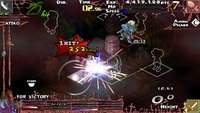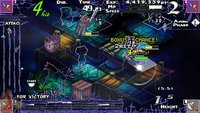|
|

|
PLATFORM
|
PSP
|
BATTLE SYSTEM
|

|
INTERACTION
|

|
ORIGINALITY
|

|
STORY
|

|
MUSIC & SOUND
|

|
VISUALS
|

|
CHALLENGE
|
Adjustable
|
COMPLETION TIME
|
20-40 Hours
|
|
OVERALL

|
+ Combines genres to powerful, creative effect.
+ Sprawling, layered story.
+ Rich, immersive visuals.
- Minor menu issues.
- Unpleasant loading times.
|
Click here for scoring definitions
|
|
|
Originality is a valued trait in console RPGs; RPGamer feels that it's important enough to be one of its six graded sub-categories. Unlike the other categories however, a high score in this category isn't necessarily a positive thing, as much as it's treated as such. It's merely an indicator that the game in question is unlike other games in the field. Innovating too far can limit a game's popular reception or isolate diehard fans of the creative team's earlier work. Take, for example, the limited commercial success of Earthbound, and how a certain subset of RPGamers refuse to accept any Final Fantasy game beyond the sixth installment. This is not a rehashing of the hardcore gamer versus casual players argument, just the observation that people don't always want to work hard to be entertained. Knights in the Nightmare engages in all of these issues and emerges mostly unscathed while masquerading as a tragic fairy tale.
The story begins in utter confusion. There's no time for introduction, as the action is already in high swing. The Lion Heart King has fallen and his twelve knightly orders have been scattered due to political machinations. Worse, monsters roam the land! It isn't until several hours in that the identity of the player's avatar -- a semi-sentient wisp of light -- is made clear. The nature of the other main character, an armored woman with a mysterious past, doesn't resolve until much later. Sepia-toned flashbacks after each battle slowly clue the player in on the entire bloody drama, but not before the narration makes maddeningly oblique references to events such as "the day of..." or "the incident." It's a dangerous technique, but here it works effectively. None of the major characters are in control of their situations, and only by moving forward can all of the fragments of rumor, memory, and truth be separated.
Character dialogue is a solid affair that explains everything in a grim, straightforward fashion. The only complaint here is a slight one: the main characters are so willful and devoted to their various schemes that there's little in the way of side material. So grandiose are the woes of Aventheim's larger-than-life players that only the secondary characters seem truly human. The disembodied narrator interjects doubt and moral complexity to the situation, but the characters act as if they're unaware of it.
Battles take place on a grid like a standard tactical RPG, but the play experience is unlike any Final Fantasy Tactics or Disgaea clone. Enemy attacks are fast, furious overlays to the standard battle grid. Quick reflexes and tense pattern recognition skills cultivated from bullet-hell shooters are both useful traits to have here. Moreover, only two of the six unit types are able to move, while all of the enemies wander around in real time. Proper unit selection and placement therefore becomes integral to success. Most of the interaction with the enemies is done through the weapon slots located in each corner of the screen. Dragging a weapon to an allied unit starts charging the attack meter – all while enemy bullets zap around the screen. Each weapon type has two different areas of effect, depending on whether the battlefield is red (chaotic) or blue (lawful). Switching between law and chaos modes influences several variables, including item drops and the abundance of attack-charging mana gems. The only way to deal worthwhile damage to anything is to grab enough gems to make charged attacks –- but this requires weapons that have charged attack capability for the required mode’s area of effect.
Control of the Wisp is tight, which helps when there're so many other factors to monitor. The analog stick controls the Wisp's direction, while the square and triangle buttons regulate its speed. Every time a character charges an attack or the Wisp is struck by an enemy bullet, the round's time limit counts down. When it reaches zero, the round is over. After a set amount of rounds, the battle ends. Victory requires defeating a set number of monsters. However, not just any monsters will do. Every enemy corresponds to a space on a tic-tac-toe-style grid, which is stocked by a slot machine mini-game between rounds. Defeating a baddie fills in its square and removes the monster from the slot machine. After a complete line is filled up, it's time to head on to the next story segment. The challenge comes in when different styles of bullets are flying everywhere, the enemies keep on walking out of range, and the most suitable weapon for the task at hand breaks. After the first few hours, the challenge of juggling all of these systems becomes a delightful target for tactical prodding, tweaking, and other assorted manhandling.
 For victory, connect four!
For victory, connect four!
|
|
Unfortunately, the system has a dark secret: beyond gamer pride, there is not much incentive to master it. On the Easy and Normal difficulties, failing in a battle provides the player with an option to retry. Unlocked treasures and enemy HP stay at the ranks they were upon death, so even the toughest battles can be won through attrition. The hardheaded approach means having a few weapons break along the way, and it doesn’t do any favors to the finite vitality of the soldiers, but the tense stakes in each battle are nevertheless defused.
The primary advantage to mastering the system is unlocking character information. Most maps have breakable scenery elements in them that hide unique key items. Presenting the proper key item to allies or NPCs in subsequent maps entices them to join the party or give up a nice weapon. Obtaining all of the key items – and therefore all of the recruitable characters – requires ingenuity or the willingness to retry each map several times. This effort is rewarded, however, as most of the impressive number of recruitable characters have enough background details to make their sudden (yet inevitable) deaths into important events. The story does not provide all of these background details: many of them must be tracked down by interrogating allies and noncombatants during glorious battle. Following this course reveals minutia too personal for the grand, central story scenes. In the context of the central plot, it doesn't matter which knights have families, who has unrequited love for whom, and how the different knightly orders interact with one another. Nevertheless, this material is important for making the player feel like a jerk for sacrificing another pawn for the glory of the kingdom. Character relationships also provide useful clues about which souls are most compatible in the Transoul system. Interested in sacrificing a daughter so that her father's maximum level will increase? Go for it, monster.
Although there's a lot to learn before the true depths of the system can be experienced, the integrated tutorial explains the important parts in bite-sized portions. After each of the first several story battles, the tutorial introduces one of the new concepts. Each of the concepts builds on the one previous to it until they're all working in conjunction. While it will probably still take several battles following the tutorials in order to master the interplay of all of the battle systems, it would be unfair to say that the in-game documentation leaves players sorely prepared for the challenge. It would be more appropriate to admit that the level of complexity is not for everyone. Even the designers of the game implicitly accept this: in order to simply finish the game, it's not necessary to understand the finer points of weapon customization, soul transfers, or even finishing battles within the provided time limits.
 Protip: Smash everything, even innocent barrels.
Protip: Smash everything, even innocent barrels.
|
|
With all of the customization options, only the most robust of menu systems would be able to function without a hitch. These menus are not those menus. While the menu system offers plenty of options for sorting one's inventory, it isn't enough for the precise situations that will arise. Scrolling through the weapon customization options quickly becomes tiring. Weapons require frequent upgrades, and culling the less useful items requires plenty of time within number-choked menus. Comparing character statistics and obtaining all of the information necessary for well-reasoned Transoul judgments also requires bookkeeping or frequent, unpleasant navigation. The loading screens are a similar annoyance; they last long enough to break the flow between scenes with two and a half images worth of background information.
Even the briefest look and listen suggests that Knights in the Nightmare has style. The backgrounds are filled with tiny, ornate details that hint at the overwrought, decadent nature of the world. The color palette is dark and frequently shrouded in setting-appropriate mist, but rich, vibrant colors shine through where they need to. Character portraits provide a lighter, less busy contrast to the baroque depths of the world. In-battle character sprites and standard enemies are merely functional, but they're made up for by the creative spectacle of the boss design and special character sprites. Each boss's special attack is worth experiencing at least once to see the creative glitz that went into the bullet effects.
The music fits the game's driving pace and tragic themes, but suffers from frequent repetition. The big and bombastic pieces are the most effective, adding the weight of a heavy fate to even the most local scenes. The slower pieces aren't as effective, but still communicate what's necessary. Voices are limited to within combat, where they're keyed to character class rather than individual characters. This shortcut is disorienting in regard to characterization, but provides useful audio cues for actions.
The DS version of Knights in the Nightmare offered several incentives to encourage multiple playthroughs, including multiple endings, unlockable difficulty levels, and a bonus storyline. The PSP version adds to this abundance with a third bonus storyline, which features the eponymous star of Yggdra Union: We'll Never Fight Alone. Unfortunately, the Yggdra-centric storyline adds very little to the central gameplay experience. It essentially follows the rails of the core story, while a dimension-swapped Yggdra questions her reason for being involved. The lackluster bonus content does not detract from the game's strengths, but rather display a missed opportunity.
In spite of being a port of a title that was first released in America in 2009, Knights in the Nightmare remains an original, enjoyable game that excels on many levels. The learning curve behind the battle system and the twisting, sprawling storyline won't appeal to every taste, but there's enough going on that even those who disagree with this assessment should check the game out for an example of something different. It offers crunch for the systems-oriented gamer and a method of narration that successfully repackages old tropes to a novel effect. Even better, Knights in the Nightmare uses the mechanics to underscore the grimness of the story: the characters are adrift in a world as uncaring and chaotic as the battle system first appears to the unwary player. As the characters come to grip with their conflicts, so too does the player. Even as order comes from the chaos, however, sacrifices must be made. Weapons break, characters draw upon their finite supply of vitality points, and the clock ticks inexorably closer to 00.00. Completing the game without intentionally sacrificing a brave, noble knight to boost the statistics of another ally is possible, but requires a conscious effort -- again drawing gamer pride into the arena.
Review Archives
|









